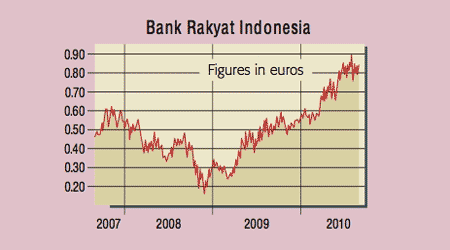
The story of rising living standards in emerging economies is well known. But one sector has lagged this trend – financial services. Commercial banks may have prospered catering to the affluent middle classes in Beijing or Delhi, but they have generally steered clear of the poorer, “unbanked” masses. Processing millions of low-value transactions is not seen as good business for the banks. And assessing credit risk is more difficult. But that’s left the door wide open for microfinance firms.
Microfinancers have spotted that bigger banks have missed out on a potential revenue stream, while the very poor are forced to rely on informal groups, such as charities or loan sharks. Many have had no access to credit at all. So the seed of microfinance, first planted by Dr. Muhammad Yunus in 1974, has grown into a branch of finance that is delivering credit to the poor and returns to investors. Dr. Yunus was a lecturer in Pakistan when he decided to loan $27 to a group of villagers. In 1983 he founded Grameen Bank. Since then, Grameen has lent more than $3bn in amounts as low as $15.
So what made microfinance work where traditional banking had failed? Firstly, the issue of credit checking is often solved by creating loans to peer groups, rather than to individuals. If a member of the group does not pay the others have to assume responsibility for the debt, or they will all be denied further credit. As a result, people are unwilling to apply for a loan alongside someone whom they consider uncreditworthy. The system works: according to The New York Times, microfinance loans have a repayment rate of more than 95%. Smaller institutions also play on local community traditions to create innovative loans. For example, some deals for women in East Africa demand the marital bed as collateral – the shame attached to losing the bed is a powerful deterrant against defaulting.
The success of Grameen Bank in the 1980s paved the way for the rapid proliferation of microfinance institutions (MFIs) in the 1990s and today. Originally these were structured as development projects, but in the last decade commercial banks and private investors have entered the sector. There are now around 1,000 microfinance institutions worldwide, offering an estimated $60bn in loans. Yet the market is far from saturated. Deutsche Bank estimates that the global demand for microfinance stands at $250bn.
This is reflected in the recent initial public offering (IPO) of Indian MFI SKS. Founder Vikram Akula raised $358m for a 21.6% stake in the company and plans to make SKS the largest MFI in the world by 2015. Yet the IPO has been criticised by Dr. Yunus. Yunus, a Nobel Peace Prize winner, feels that MFIs should not make a profit and says the IPO “sends the wrong message”.
Controversy over profit has raged since the arrival in the sector of ‘for-profit’ organisations that charge net interest rates of up to 80% for loans. Yet Mark Turner of Turner Investment Partners estimates that “dubious microfinance institutions amount to fewer than 5% of the total”. And many MFIs are signatory to a code of conduct designed to prevent unethical treatment of clients.
Criticisms aside, the SKS IPO is generally seen as a sign of things to come. Analysts are predicting that more will follow as MFIs seek to raise the huge sums of capital demanded by the poor worldwide. In the box below we take a look at some of the best options for investors.
The best bet in the sector
When the SKS IPO is complete it will be only the second listed company devoted entirely to microfinance. The other is Mexican outfit Compartamos (BMV:COMPART). But according to the Asia Resource Centre for Microfinance, to access “the world’s largest and most profitable microfinance network”, investors need to look at Bank Rakyat Indonesia (BYR: GR).
The oldest bank in Indonesia, Bank Rakyat has roots in a mosque lending scheme. As such, it is a commercial bank, but micro loans now form 28% of its loan book. So it’s not a pure play on the sector in the same way as SKS or Compartamos. That gives it a big advantage: customers who succeed thanks to its microfinance loans can become higher-value clients. Another advantage it offers compared with listed MFI rivals is a secondary listing in Germany, which makes trading its shares easier and cheaper. It also boasts the most extensive network of branches in Indonesia and claims repayment rates of 98.3% on its microloans. Plus it offers micro-saving. Credit Suisse believe that the Indonesian microfinance market will continue to grow until 2019. Bank Rakyat Indonesia is a relatively cheap way in on a p/e multiple of 10.8 for 2011.
• This article was originally published in MoneyWeek magazine issue number 501 on 27 August 2010, and was available exclusively to magazine subscribers. To read more articles like this, ensure you don’t miss a thing, and get instant access to all our premium content, subscribe to MoneyWeek magazine now and get your first three issues free.